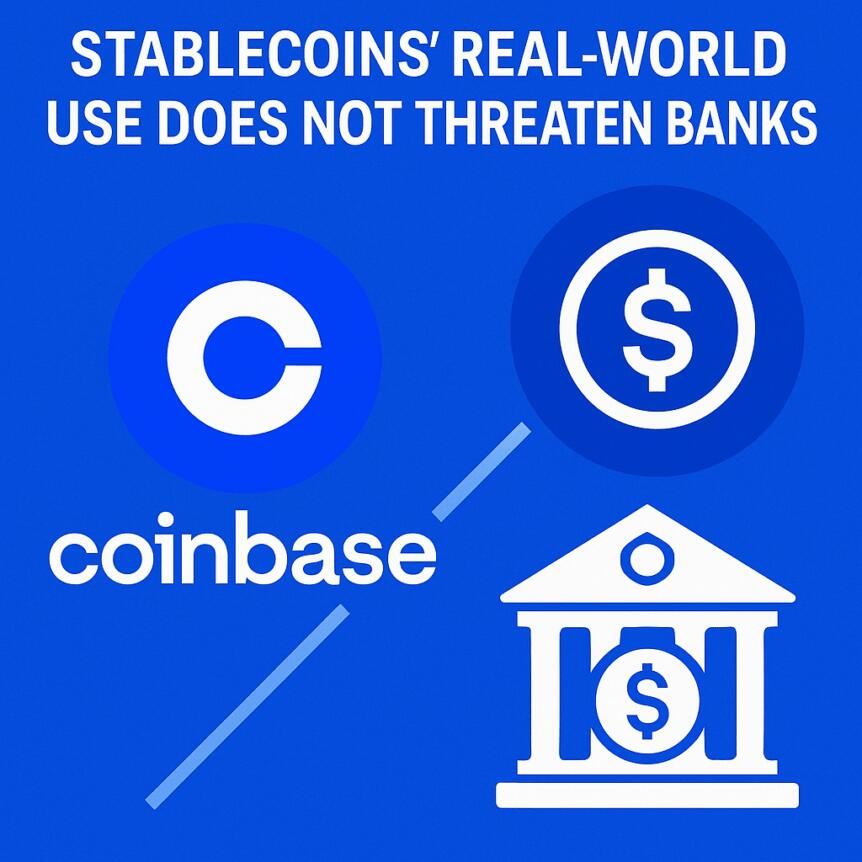Coinbase: Stablecoins’ Real-World Use Does Not Threaten Banks

In the ongoing debate over crypto regulation, stablecoins have often been painted as potential threats to traditional banking systems. However, recent insights from Coinbase suggest that these concerns may be overstated, highlighting the global utility and evolving role of stablecoins in the financial landscape. Coinbase’s analysis emphasizes that stablecoins are primarily serving international markets and enhancing dollar dominance, rather than directly competing with American banks. As the entity explores this dynamic, it underscores the importance of understanding the real-world applications of these tokens amid growing discussions on their regulation and impact.
- Coinbase asserts stablecoins are not a threat to US banking deposits, as most demand is international.
- Stablecoins primarily serve emerging markets and the underbanked, offering dollar exposure and hedging against local currency depreciation.
- Two-thirds of stablecoin transactions occur on DeFi or blockchain platforms, functioning as part of a new financial layer outside traditional banks.
- Concerns about stablecoins draining US bank deposits are viewed as overstated, given their global and transactional nature.
- Coinbase calls for balanced regulation, emphasizing stablecoins’ role in strengthening dollar influence and supporting innovation.
Stablecoins’ Global Role in the Financial Ecosystem
Concerns that stablecoins could undermine US banks by cannibalizing deposits have been met with skepticism by Coinbase researchers. Coinbase policy chief Faryar Shirzad explained that “most stablecoin demand comes from outside the US, expanding dollar dominance globally, not competing with local banks.” He stressed that the narrative implying stablecoins threaten bank lending oversimplifies their actual use cases.
Shirzad’s note highlights that a significant portion of stablecoins are used in international markets for dollar exposure, especially in emerging economies where they act as a hedge against local currency depreciation. For the underbanked, stablecoins serve as a practical alternative for access to dollar-based financial services.
He further pointed out that approximately two-thirds of stablecoin transfers happen on decentralized finance (DeFi) platforms, functioning as part of a new transactional infrastructure that operates parallel to, but largely outside of, traditional banking systems. This shifts the narrative from competition to complementarity, strengthening the dollar’s role in global finance.
Source: Faryar ShirzadCommunity Banks and Stablecoins: Misconceptions or Opportunities?
Contrary to some fears, Coinbase also dismisses the idea that stablecoins will cause community banks to collapse. Research indicates that typical stablecoin users are quite different from the usual bank customers, meaning there is minimal overlap. Shirzad believes banks could actually benefit from integrating stablecoins, enhancing their service offerings rather than facing obsolescence.
Despite speculation about trillions of dollars flowing into stablecoins in the coming decade, Coinbase warns that these projections should be interpreted with caution. Even with a global stablecoin market of $5 trillion, most of that value would remain outside of US deposit accounts or be held in digital settlement systems, not directly competing with American savings.
Coinbase emphasizes that US bank deposits—exceeding $18 trillion—are unlikely to be significantly impacted by stablecoin activity, especially considering their international and transactional use cases. The firm advocates for balanced regulation that recognizes stablecoins’ role in reinforcing dollar dominance and fostering innovation in the digital economy.
In recent months, many large banks and financial institutions have begun to explore or launch stablecoin services, especially following the USGenius Act, which clarifies the regulatory approach toward stablecoin providers.
This article was originally published as Coinbase: Stablecoins’ Real-World Use Does Not Threaten Banks on Crypto Breaking News – your trusted source for crypto news, Bitcoin news, and blockchain updates.
You May Also Like

“Circle Just Solved the $29 Trillion Crypto Adoption Problem

Speculation as Culture
